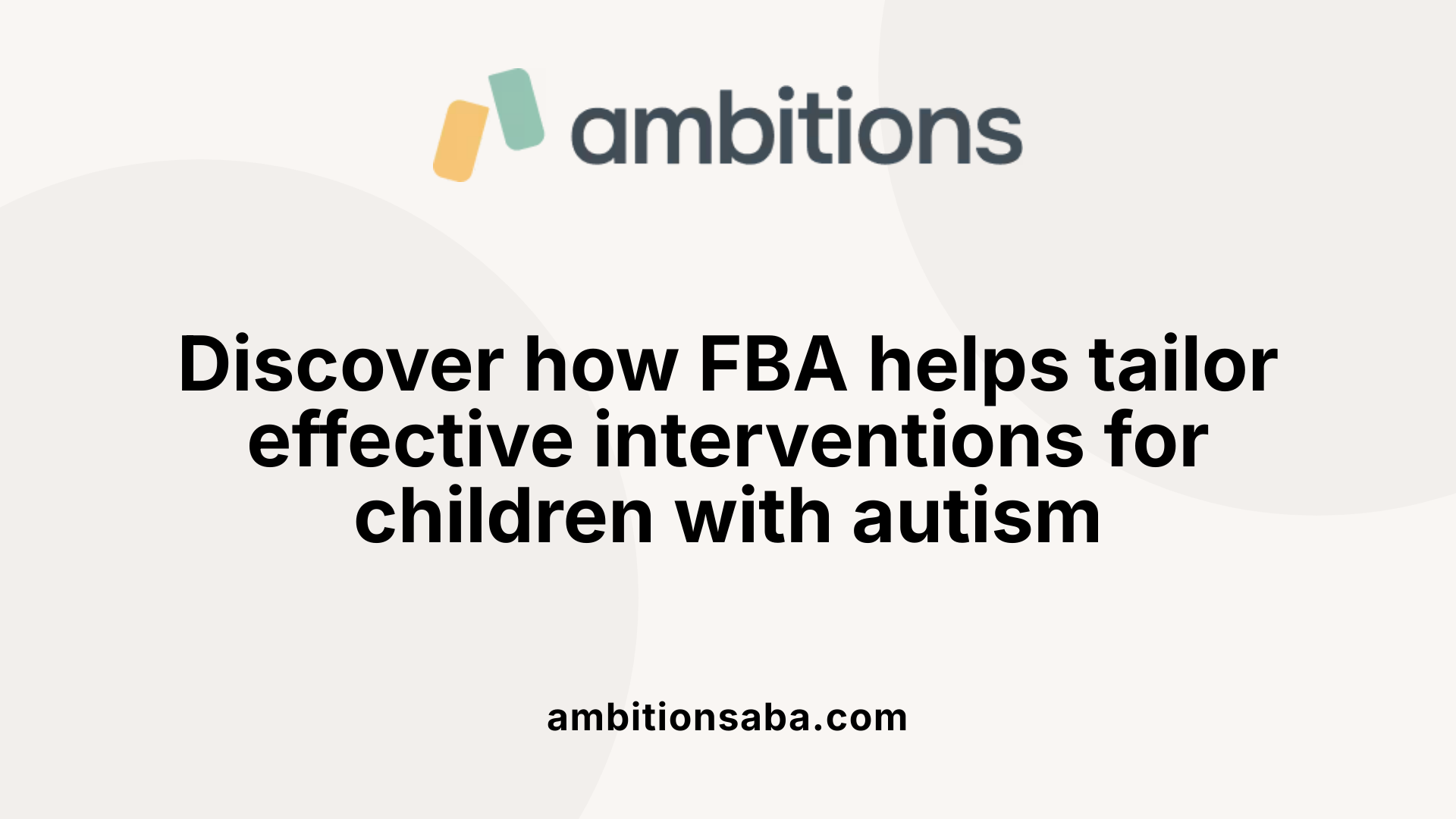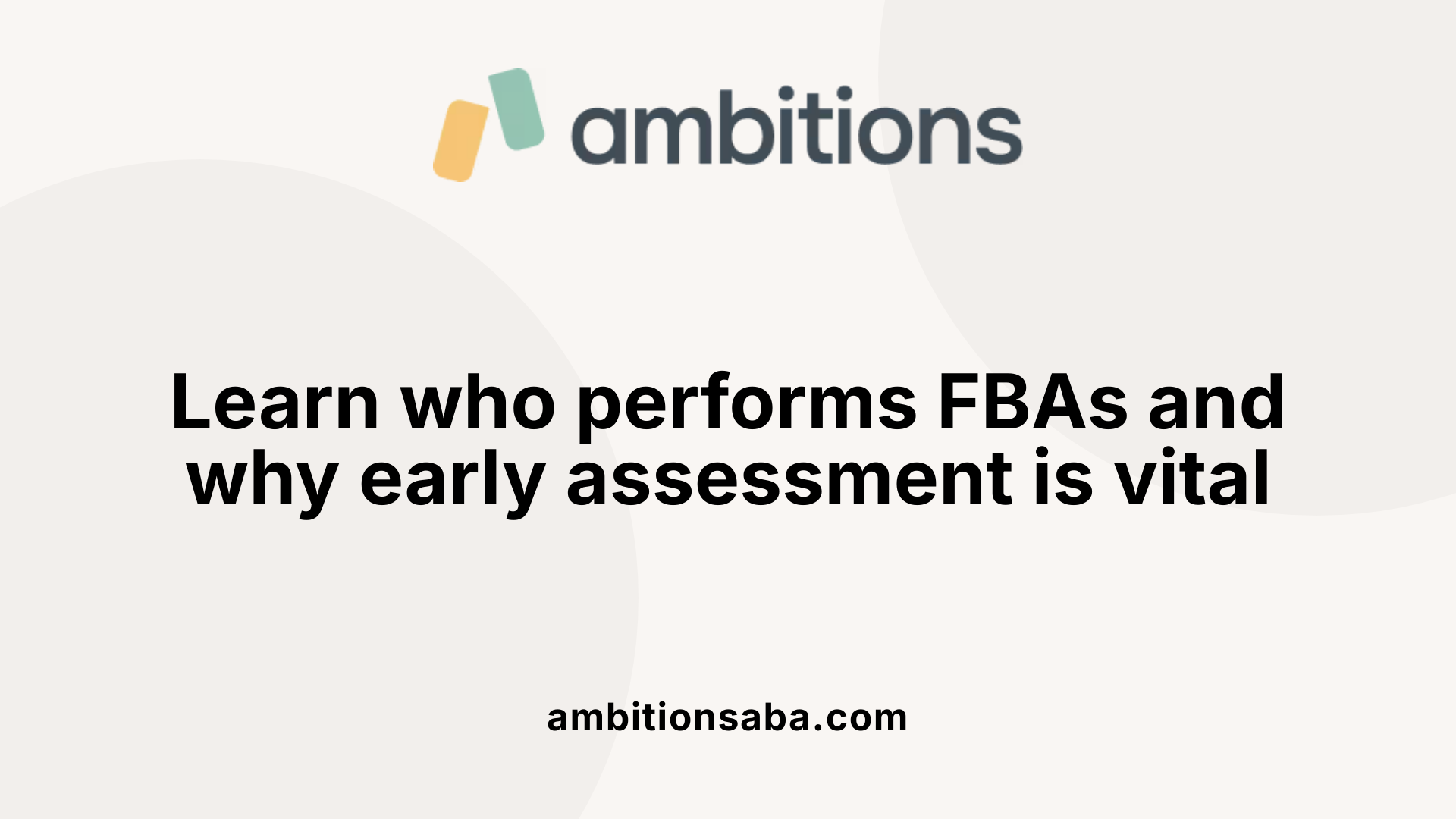Navigating the Pitfalls of Reinforcement in Parenting
Understanding the Essentials of Functional Behavioral Assessments
Functional Behavioral Assessment (FBA) is a cornerstone of Applied Behavior Analysis (ABA) therapy, especially for children with autism. It systematically identifies why challenging behaviors occur, thereby guiding effective interventions. This article explores what families and professionals can expect during an FBA and how it plays a crucial role in improving behavioral and developmental outcomes.
What Is Functional Behavioral Assessment and Its Role in ABA Therapy?

Understanding Functional Behavioral Assessment (FBA) in ABA
Functional Behavioral Assessment (FBA) is an essential component within Applied Behavior Analysis (ABA) therapy aimed at deciphering why challenging behaviors occur in children with autism. This systematic, evidence-based process examines the ABCs of behavior: antecedents (what happens before the behavior), the behavior itself, and consequences (what follows). The goal is to understand the function or purpose of the behavior, such as gaining attention, escaping demands, accessing specific items, or receiving sensory stimulation.
Purpose of FBA in Addressing Challenging Behaviors
FBA’s primary role is to identify the environmental triggers and reinforcements that maintain interfering behaviors. These behaviors might include aggression, self-injury, tantrums, or property destruction, which could affect safety, learning, or social development. By pinpointing what drives such behaviors, FBA helps in crafting targeted strategies to reduce their occurrence while promoting more adaptive alternatives.
From Assessment to Personalized Intervention Plans
The data collected through interviews, direct observations, and behavior tracking tools allows behavior analysts to hypothesize behavior functions and test these through interventions. FBA guides the creation of individualized behavior intervention plans that teach replacement behaviors serving the same function as the problematic ones. This personalized approach, grounded in continuous monitoring and adjustment, maximizes the effectiveness of ABA therapy, supporting better communication, adaptive skills, and overall quality of life for children with autism.
Brief Overview of ABA Therapy
ABA therapy uses principles of learning and behavior analysis to assist individuals with autism in acquiring meaningful skills. Through structured techniques like positive reinforcement and data-driven methods, ABA aims to increase desirable behaviors and reduce harmful ones, overseen by certified professionals such as BCBAs.
Who Conducts Functional Behavioral Assessments and When Are They Done?

Which qualified professionals conduct Functional Behavioral Assessments?
Functional Behavioral Assessments (FBAs) are primarily conducted by Board Certified Behavior Analysts (BCBAs) and Board Certified Assistant Behavior Analysts (BCaBAs), experts specifically trained in ABA therapy and behavioral analysis. Additionally, licensed psychologists and ABA therapists with proper qualifications may participate in the FBA process. This multidisciplinary involvement ensures comprehensive evaluation and carefully tailored interventions.
When is the ideal time to perform an FBA?
FBAs are ideally conducted early in the course of ABA therapy, soon after challenging behaviors are identified. Early assessments allow clinicians to understand the underlying reasons behind behaviors and develop effective behavior intervention plans promptly. However, an FBA can be performed at any stage, especially if existing behaviors change, escalate, or new problematic behaviors arise. Ongoing assessment is critical to adapting strategies in response to developmental changes or shifting behavior functions.
Why are repeated or ongoing FBAs beneficial?
Different challenging behaviors may serve different functions for an individual, requiring separate FBAs to address each effectively. As children grow and their environments change, the function of a behavior may also shift, making periodic reassessment essential. Ongoing data collection and analysis help refine interventions over time, ensuring sustained progress and improved quality of life.
Who typically provides ABA therapy for autism?
ABA therapy is typically provided by trained professionals such as BCBAs, BCaBAs, and Registered Behavior Technicians (RBTs), who design and implement personalized behavior plans. Other professionals, including psychologists and speech-language pathologists, often contribute within their specialties to support overall treatment goals. This collaborative approach enhances the effectiveness of ABA therapy for children with autism.
Step-by-Step Breakdown of the Functional Behavioral Assessment Process

Initial Ruling Out of Medical Issues
Before beginning a Functional Behavioral Assessment (FBA), it is essential to rule out any medical concerns that might be contributing to the challenging behavior. This step ensures that behaviors are not symptoms of physical health problems and helps focus the assessment on behavioral causes.
Interviews with Parents, Caregivers, and the Individual
Conducting interviews with parents, caregivers, and sometimes the individual themselves provides valuable background information. These interviews help clarify the behaviors of concern, the context in which they occur, and any known triggers or consequences. Gathering developmental history and environmental details sets the foundation for the FBA.
Direct Observations and Data Collection Methods
Observations are conducted in various settings and times to capture behavior patterns accurately. Data collection tools such as ABC (Antecedent-Behavior-Consequence) charts track what happens immediately before and after the behavior. Additional methods like scatterplots document when behaviors occur, and event or duration recording measures frequency and length of behaviors. These approaches provide a comprehensive picture of behavioral occurrences.
Analysis of Antecedents, Behaviors, and Consequences
The collected data is analyzed to identify patterns in antecedents (triggers), the behaviors themselves, and consequences (responses that follow). This analysis helps determine what maintains the problem behavior, focusing on environmental factors influencing it.
Forming and Testing Hypotheses About Behavior Functions
Based on the data, hypotheses are developed about why the behavior occurs—functions often include seeking attention, escaping demands, accessing items, or sensory stimulation. These hypotheses direct the development of intervention strategies.
Use of Functional Analysis When Appropriate
Although not always necessary, a functional analysis may be conducted to test hypotheses in controlled conditions. This involves manipulating antecedents and consequences to observe changes in behavior, which strengthens the understanding of its function and informs tailored interventions.
Through this multi-step FBA process, clinicians gather critical insights leading to evidence-based, individualized behavior intervention plans that effectively address challenging behaviors in children with autism.
Understanding Behavioral Functions to Tailor Effective Interventions

What Are the Common Behavior Functions in Autism Therapy?
Behaviors often serve particular purposes, classified into four main functions: seeking attention, escaping or avoiding demands, gaining access to preferred objects or activities, and automatic reinforcement (sensory stimulation). Recognizing these functions helps clarify why a child with autism might engage in challenging behaviors like tantrums or self-injury.
How Does Identifying Behavior Function Guide Intervention Selection?
By understanding what reinforces a behavior, professionals can design targeted interventions that directly address the underlying cause. For example, if a behavior is maintained by attention, the intervention would focus on providing attention only for appropriate behaviors, while withholding it when the problematic behavior occurs.
What Is the Role of Teaching Replacement Behaviors?
An effective strategy involves teaching alternative behaviors that fulfill the same function as the challenging one. For instance, a child who seeks attention by yelling might learn to request attention appropriately instead. This helps reduce problem behaviors while meeting the child's needs.
What Are Extinction Bursts and Why Are They Important?
When interventions begin, behaviors sometimes temporarily worsen before improving—a phenomenon called an extinction burst. Understanding this helps caregivers maintain consistency and not be discouraged during initial setbacks, ensuring the interventions' success.
Why Is Consistency Across Caregivers and Settings Critical?
Consistency is vital for the effectiveness of behavior interventions. When all caregivers respond uniformly to behaviors and use the same strategies, children receive clear and consistent messages, promoting faster and more lasting positive behavior changes.
Core Principles Behind Behavioral Analysis in Autism Therapy
Behavioral analysis in autism therapy is rooted in learning science, using systematic observation and environmental interventions to modify behavior. Techniques include positive reinforcement, functional behavior assessment (FBA) to understand behavior causes, and strategies like prompting and extinction to build skills and decrease unwanted behaviors. This individualized, data-driven approach supports meaningful and sustainable behavioral improvements.
| Aspect | Description | Example |
|---|---|---|
| Behavior Function | Purpose served by behavior (attention, escape, access, sensory) | Tantrums to avoid difficult tasks |
| Intervention Matching | Selecting interventions based on identified function | Providing attention after appropriate requests instead of tantrums |
| Replacement Behavior | Alternative behavior serving the same function | Teaching to ask for a break instead of eloping |
| Extinction Burst | Temporary increase in target behavior following intervention start | Behavior intensifies briefly when reinforcement is withheld |
| Consistency | Uniform strategy application across caregivers and environments | Families and therapists responding similarly to a behavior |
How Families Can Prepare for and Benefit from an FBA
Parental Role in Data Gathering and Collaboration
Families play a crucial role in the Functional Behavioral Assessment (FBA) process. Parents provide valuable developmental history and contextual information that helps analysts understand the child's environment and behavior triggers. Their active collaboration with qualified professionals supports accurate data collection and ensures interventions are tailored to the child's unique needs.
Preparation Steps
Before beginning an FBA, parents are advised to rule out medical concerns that could contribute to the challenging behavior. Gathering comprehensive developmental history and previous evaluations helps guide the assessment. This preparation enables the behavior analyst to focus on behavior functions rather than underlying health issues.
Accessing Qualified Professionals and Navigating Insurance or Funding
Parents should seek evaluations from credentialed professionals such as Board Certified Behavior Analysts (BCBAs) or licensed psychologists experienced in ABA and FBA procedures. Consulting healthcare providers, educational specialists, or local agencies can facilitate referrals. Exploring insurance coverage, including Medicaid or private plans, and government or regional center funding can support access and sustain therapy services.
Long-term Benefits of FBA-informed Interventions for Children with Autism
Effective FBA-driven interventions identify the specific reasons behind challenging behaviors and replace them with appropriate alternatives. This personalized approach enhances communication, adaptive skills, and overall quality of life. Early and continuous participation by families further optimizes long-term developmental outcomes.
Importance of Ongoing Monitoring and Adjustment in Therapy
Behavioral interventions are not static; ongoing data collection and analysis are critical. Families and professionals must regularly review progress and modify strategies as needed to address developmental changes or evolving behavior patterns, ensuring interventions remain effective over time.
Functional Behavioral Assessment: A Vital Tool for Behavioral Success
The Functional Behavioral Assessment is an evidence-based, systematic process that uncovers the reasons behind challenging behaviors in children with autism. By engaging qualified professionals and collaborating closely with families, FBAs enable the design of individualized interventions that not only reduce problematic behaviors but also promote communication, social skills, and adaptive functioning. Understanding what to expect during an FBA empowers families to play an active role and facilitates better outcomes, reinforcing the importance of this assessment as a foundation for effective ABA therapy.
References
- 2025 Guide to Functional Behavior Assessments in ABA
- Functional Behavior Assessment (FBA) - ---EBP Brief Packet
- Functional Behavioral Assessment: What Is It?
- 10 Steps to Understanding and Writing a Functional ...
- Understanding Functional Behavior Assessment
- Functional Behavior Assessment (FBA)
- Functional Behavioral Assessment | FBA for Kids with Autism
- Practical Functional Assessment | Understanding Problem ...

